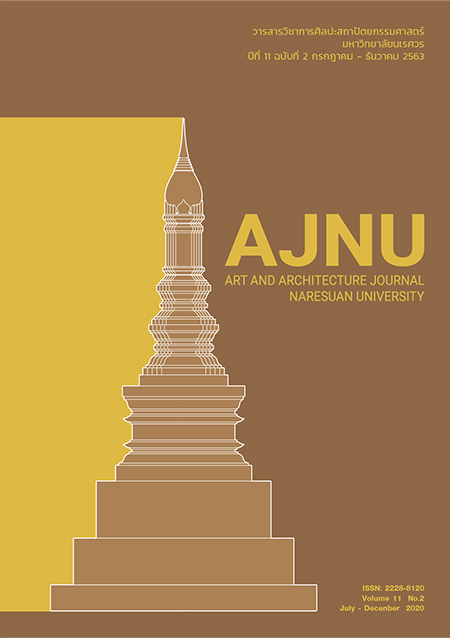The experimental design on the facades of Roi et provincial hall
Main Article Content
Abstract
Roi Et Provincial Hall has been redeveloped according to the policy of the Government Center System Organization, which designates a provincial hall as the center of the provincial government and shall express its local identity. Roi Et Province, thus, has carried out the redevelopment project of the provincial hall of which design has been adhered to a tetrahedron style (a building with four gable ends), a standard building design provided from the central government, and combined with its local identity derived from architectural elements on the facades to present inherited meaning to people’s perception. This study aims to find the architectural elements which provide identity on the façade of Roi Et Provincial Hall. The method used includes an investigation of the architectural elements on the facades which affect perception in 3 aspects: mass-form, ornament and texture. The study consists of three steps: 1) an investigation of the old hall’s façade, 2) an investigation of local identity buildings’ façade, and 3) an interpretation of identity to a design. Finally, a 3D model of Roi Et Provincial Hall is developed.
Article Details
References
กรมศิลปากร. (2531). ปราสาทพนมรุ้ง. กรุงเทพ: อมรินทร์ พริ้นติ้ง กรุ๊พ.
ณัฎฐกิตติ์ เพ็ชรสุริยา. (2556). ความชื่นชอบรูปด้านหน้าอาคารแถวในเมืองเก่าลำปาง (วิทยานิพนธ์มหาบัณฑิต), คณะสถาปัตยกรรมศาสตร์, มหาวิทยาลัยเชียงใหม่.
ติ๊ก แสนบุญ. (2557). ลักษณะขอมในเชิงช่างไทยอีสานร่วมสมัย. ศิลปวัฒนธรรม, (เมษายน 2557). สืบค้นเมื่อ 19 เมษายน 2560, จาก https://www.silpa-mag.com/history/article_8380
ธาดา สุทธิธรรม. (2544). ผังเมืองในประเทศไทย: ผังชุมชนและการใช้ที่ดินสายอารยะธรรมเขมรในภาคตะวันออกเฉียงเหนือ (พิมพ์ครั้งที่1). ขอนแก่น: พิมพ์พัฒนา
นราธร สายเส็ง. (2560). ธรรมชาติของมนุษย์กับมุมมองเชิงพื้นที่. Veridian E-Journal, 10(1), 635-646.
นิติ เชื้อสถาปนศิริ. (2544). ความหมายทางการเมืองของลักษณะทางสถาปัตยกรรมของอาคารราชการไทย :กรณีศึกษาศาลากลางจังหวัด (วิทยานิพนธ์มหาบัณฑิต), ภาควิชาการปกครอง, คณะรัฐศาสตร์, จุฬาลงกรณ์มหาวิทยาลัย.
วิมลสิทธิ์ หรยางกูร, กอบกุล อินทรวิจิตร, สันติ ฉันทวิลาสวงศ์ และ วีระ อินพันทัง (2536). พัฒนาการแนวความคิดและรูปแบบของงานสถาปัตยกรรม: อดีต ปัจจุบัน และอนาคต. กรุงเทพฯ: สมาคมสถาปนิกสยามในพระบรมราชูปถัมภ์
สันต์ สุวัจฉราภินันท์, ทวีศักดิ์ เกียรติวีระศักดิ์ และ รัฏฐา ฤทธิศร. (2555). สัญวิทยา: การถอดรหัสและการประยุกต์อัตลักษณ์ไทยเพื่อเป็นแนวทางการออกแบบ. โครงการจัดประชุมวิชาการ ประจำปี2555 BERAC3 คณะสถาปัตยกรรมศาสตร์และการผังเมือง มหาวิทยาลัยธรรมศาสตร์, 86-102. สืบค้นจาก http://www.berac.tds.tu.ac.th/BERAC/BERAC%203/8%20Sant%20Suwacharapinan%20et%20al.pdf
สำนักงานเลขาธิการคณะรัฐมนตรี. (2553). การประชุมคณะกรรมการอำนวยการจัดระบบศูนย์ราชการ ครั้งที่2/2553. สืบค้นจาก http://www.cabinet.soc.go.th/soc/Program2-3.jsp?top_serl=224305
สุจิตต์ วงษ์เทศ. (2555). ร้อยเอ็ดมาจากไหน (พิมพ์ครั้งที่ 2). กรุงเทพฯ: ชนนิยม.
อาภาภรณ์ วงศ์ลักษณพันธ์ (2556). การทดสอบการรับรู้รูปด้านหน้าอาคารชิโน-โปรตุกิส บนถนนถลาง จังหวัดภูเก็ต (วิทยานิพนธ์มหาบัณฑิต), คณะสถาปัตยกรรมศาสตร์, มหาวิทยาลัยเชียงใหม่.
อาภาภรณ์ วงศ์ลักษณพันธ์ (2557). การเปรียบเทียบการรับรู้รูปด้านหน้าอาคารต่างยุคของอาคารชิโน-โปรตุกีส บนถนนถลาง จังหวัดภูเก็ต, วารสารวิชาการ การออกแบบสภาพแวดล้อม, 1(1): 45-58.
Askari, A. H. and Dola, K. B. (2009). Influence of building façade visual element on its historical image: Case of Kuala Lumper city, Malaysia. Journal of Design and Built Environment, 5, 44-59.
Gifford, R., Hine, D. W., Muller-Clemm, W., JR, D. J. R., and Shaw, K. T. (2000). Decoding modern architecture: A lens model approach for understanding the aesthetic differences of architectures and laypersons, Journal of Environment and Behavior, 32(2), 163-187.
Herzog, T. R., Kaplan, S., and Kaplan, R. (1982). The predictation of preference for unfamiliar urban place. Journal of Population and Environment, 5(1), 43-59.
Imamoglu, C. (2000). Complexity. preference and familiarity: architecture and non-architecture Turkish students’ assesments of traditional and modern house façade. Journal of Environmental Psychology, 20(1), 5-16
Marina, M., and Rento, T. (2006). Aesthetic, perception and preference for historical and modern buildings. Journal of Cognitive Processing, 7(1), 66-67.
Mehrabian, A., and Russell, J. A. (1974). An approachto environmental psychology. Cambridge, MA: MIT press.
Russell, J. A., Ward, L. M., and Pratt, G. (1981). Affective quality attributed to environments: A factor analysis study, Journal of Environment and Behavior, 13(3), 259-288.
Stamps, A. E. (1999). Architectural detai, Van der Laan septaves and pixel counts. Journal of Design Studies, 20(1), 83-97
Stamps, A. E. (2000). Psychology and the Aesthetics of the Built Environment. New York: Kluwer Academic Publishers.
Tok, Y. S., Kaplan, I., and Taneli, Y. (2010). Photography in architectural education: A tool for assesing social aspects of the built environment. ScienceDirect Procedia Social and Behavioral Sciences, 2, 2583-2588. doi: 10.1016/j.sbspro.2010.03.377
Tze Ling Li. (2007). A study of ethic influence on the façade of colonial shophouse in Singapore: A case study of Telok Ayer in chinatown. (Ph.D.) University of Tokyo, Tokyo.


